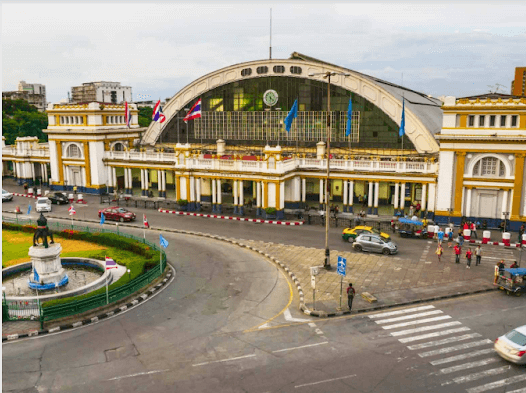
Hua Lamphong railway station
Few public buildings have carried such a richly nostalgic, fascinating and diverse history as Bangkok’s main railway station, Hua Lamphong (Thai: สถานีรถไฟหัวลำโพง, also spelled Hualamphong). It is commonly referred to by the Thais as “Sathani Rotfai Krung Thep”. Now after more than a century of service, this rail terminal will finally close operations and become a large railway museum in 2020. Bangkok’s main railway hub is being moved North to the existing Bang Sue railway station. This new and greatly expanded main rail terminal is projected to start operations shortly. With the old station closing down operation an important chapter in the country’s transportation history will finally end. However, there is no question the terminus has touched the lives of millions of Thai and foreign rail travellers for over 100 years.
The terminal building was constructed right at the edge of Chinatown at the start of the 20th century, then a still uninhabited area on the edge of the city. This whole area was formerly called “Thung Woa Lamphong” or “The field of the wild ox” for some Indian cattle owners who let their herds of cattle roam around grazing on the grassy plain unsupervised. The term was later changed to the current title Hua Lamphong. Now in the centre of Pathumwan District, it is also in close proximity to the MRT station also called Hualamphong, the closest Chao Phraya River landing is the Tha Ratchawong Pier on the other side of Chinatown, Silom Road, one kilometre away, and Rama IV Road in front of the station. There are also city busses, taxis, tuk tuks and motorcycle taxis outside next to the terminal.
What would become the State Railways of Thailand (SRT) started in 1897 as national railway service commenced. The site of the Hua Lamphong railway station was previously used as the railroad’s maintenance centre. This was moved out to Makkasan in June 1910.
The conception for the actual main railway terminal building was from a state visit to Frankfurt, Germany by King Rama V in 1907. On viewing the classical beauty of Frankfurt’s main railway station, the King was inspired. He gave directives to create a station similar to Frankfurt’s station. Construction was started in 1910. The architectural structure borrowed from De Stijl Dutch design influences, with two toned, stained glass, patterned skylights, a grand portico in the front entrance, large main hall, and a curved or vaulted iron roof. Although there were some Dutch architects involved in the design, it was the Mario Tamagno, the renown local Italian architect, who was primarily responsible for the Italian Neo-Renaissance building’s design. He also designed the Ananta Samakhom Throne Hall or Parliament Building, the Bank of Thailand Museum and the Neilson Hays Library.
After six years of construction during the reign of King Rama VI, the station was opened on 25 June 1916 to much fanfare. At the location of the smaller, original railway station that was nearby, a pillar commemorates the inauguration of Thailand’s railway service in 1897. Initially the railway terminal building served both as a passenger and freight terminus. The Royal State Railways Thailand (RSR) changed its name to simply the State Railway of Thailand (SRT) in 1951. That same year the first automated ticketing machine was brought into use for train tickets in the country. Prior to this all tickets were handwritten, the same case with train tickets in some Asian countries like Myanmar. The ticket stamping machines were purchased from Germany. They stamped small rectangular tickets with the number of the train and the date. In 1960, the station was redeveloped to be used solely as a passenger terminal. There is also a small railway museum inside the main terminal building.
Hua Lamphong station serves over 130 trains with approximately 60,000 passengers per day. The main hall is always bustling with passengers coming and going, plenty of jammed luggage carts and busy porters plus pushcart vendors. There are 26 ticket booths, 20 platforms, several electronic display boards, an advanced booking office, a left luggage office, several restaurants, shops and services including a tourist centre, a mail centre and an information desk. Hua Lamphong is the rail hub for the whole country. All Northern, Southern, Northeastern, and Eastern Train Lines have the station as their initial or terminal stop. Trains for Thailand’s Western trips depart from the Thonburi rail station on the other side of the Chao Phraya River.
Hua Lamphong will always be an important part of Thailand’s history.



